In October, British Columbian voters will receive ballots asking them two questions. First, should BC use First-Past-the-Post (FPTP) voting or proportional representation (ProRep)? Second, if the province chooses ProRep, which of three systems do voters prefer: Dual Member Proportional, Mixed Member Proportional, or Rural-Urban PR?
All three ProRep options follow a few ground rules: each would fairly reflect the will of voters, give voters a local representative, and keep the size of the Legislative Assembly about the same, growing by no more than a few members. Any fringe parties with less than 5 percent of the vote can’t get a seat.
ProRep is the most commonly used voting system in advanced countries around the world. Canadian voters tried it out during the Progressive Era but contemporary BC voters have not used it, so we thought a visual cheat-sheet would help to remember what the options would be like. Think of a community garden as a metaphor for voting. Imagine the community chooses to grow vegetables in the way that voters choose elected representatives. Each plot in the garden represents a district; each plant represents an MLA; each group of people that chooses the plants and tends a plot are the voters. Let’s walk through the BC ballot options using this metaphor and see how different systems of voting yield different results.
Question 1: First Past the Post (FPTP) or Proportional Representation (ProRep)?
First-Past-the-Post (FPTP)
Say this garden has lots of small sections with a few people each tending each one. Gardeners vote to decide what they’ll plant in their assigned section. Tomatoes win the most votes in every section. They don’t necessarily get a majority of votes because all the votes for other veggies are split. For example, in one section tomatoes get 40 percent while peas get 32 percent, cucumbers 28 percent. That section grows tomatoes. The pea people and the cucumber people don’t get the veggie they prefer. In the overall garden, almost everyone grows tomatoes even though the majority of people didn’t want tomatoes. That’s First-Past-the-Post, also called winner-take-all (tomatoes take all in each section, even if they only got 40 percent of the vote).
Proportional Representation (ProRep)
There are many ways to arrange a ProRep garden; BC voters get to choose from the three options described below. But what almost all ProRep variations have in common is the garden has bigger sections with more people tending each—and more people’s tastes reflected. One plot might grow peas, lettuce, berries, tomatoes, and cucumbers. Another might grow tomatoes, cucumbers, beans, and squash depending on what people in that plot really like. Altogether, the garden reflects the diversity of the community. That’s proportional representation. The veggies would be grown in proportion to the share of votes.
Question 2: Which of the following three systems do you prefer?
Dual Member Proportional (DMP)
Each section of the garden is smaller and has enough for two kinds of plants. The first plant in each section is that group’s favorite—mostly tomatoes. But the second plant is chosen by counting both what local gardeners’ and all the other gardeners want. That way the garden overall grows a representative mix of veggies.
Mixed Member Proportional (MMP)
The garden has some small, single-plant plots, but also has some larger sections. Each gardener gets a say in what grows in one small plot and one large plot. The small plots end up with a lot of tomatoes, as before, but gardeners are still able to get their choice for other veggies like cucumbers, snap peas, and berries in their larger shared sections. Most people have at least one food they like in either their small or large plot. Overall, the garden supplies a healthy mix of foods.
Rural-Urban Proportional Representation
This garden mostly has larger plots and gardeners rank their favorite veggies and grow the top five proportionally. A few sections stay as one-plant plots. The garden still produces lots of tomatoes but also grows peas and cucumbers in proportion to gardeners’ choices. Altogether, the garden reflects the diversity of the community.
This system is designed to ensure rural ridings don’t get too big. The larger sections of the garden represent urban ridings, where five current ridings can join together and still be a compact 100-meter square, enough for voters to easily reach their MLAs. The one-plant plots represent rural ridings which would stay as is, so voters don’t get any further from their MLA.

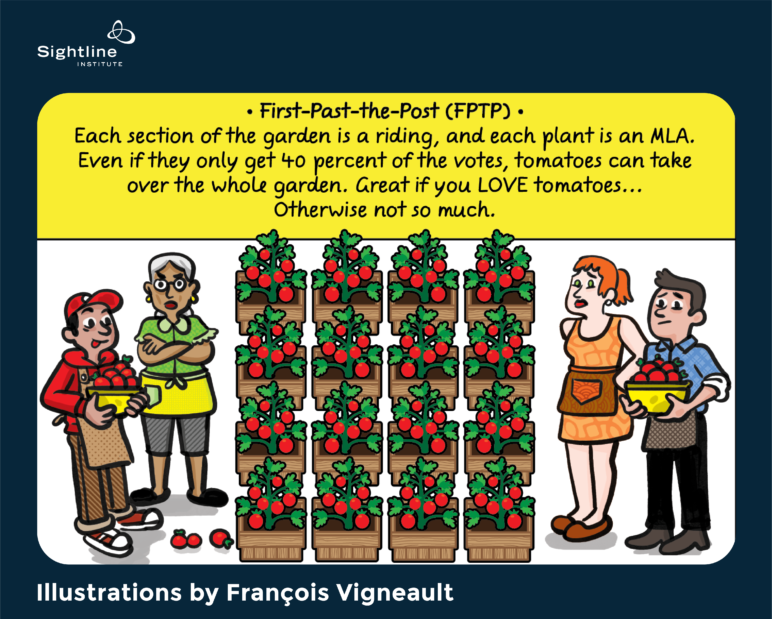
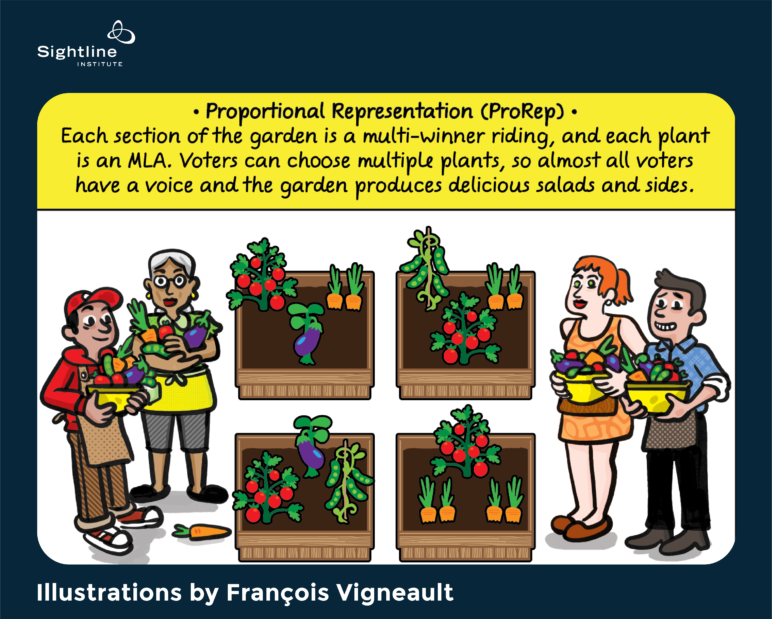
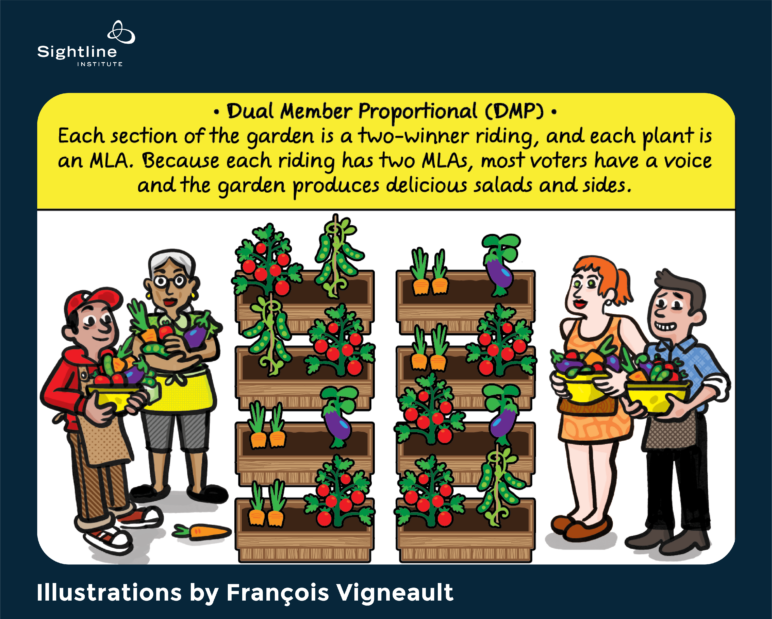
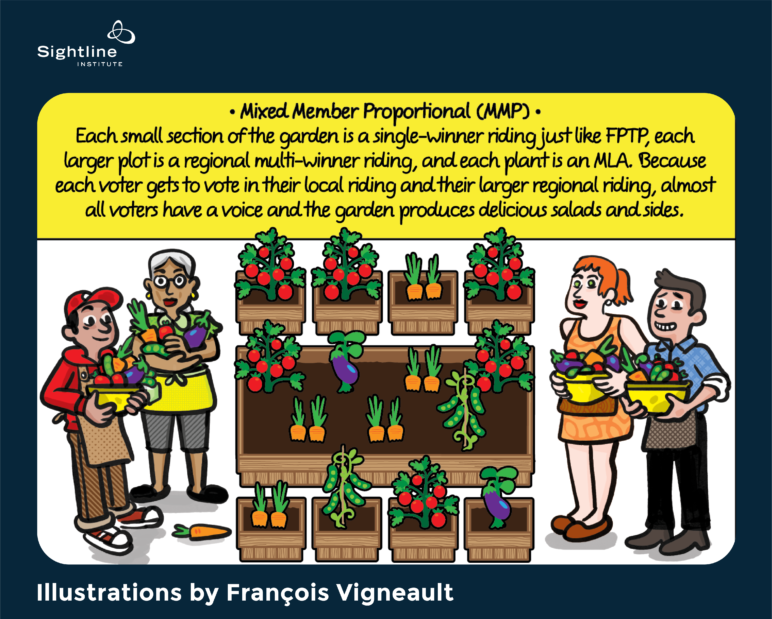
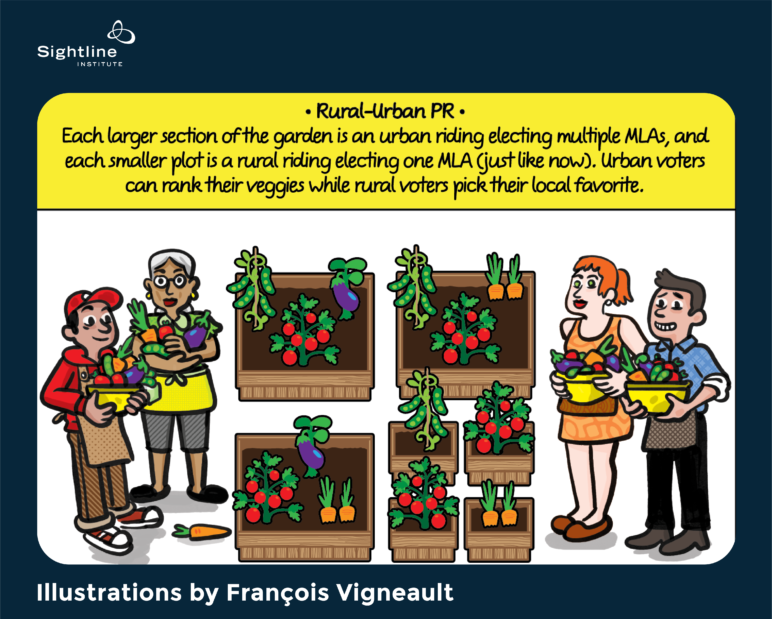

Comments are closed.